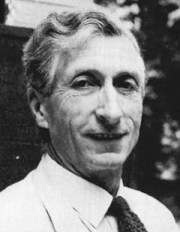

Charles A. Coulson

Born 13 December 1910, in Dudley, Worcestershire, England. Died 7 January 1974 in Oxford, England. Professor of Theoretical Chemistry, University of Oxford.
Fellow of the Royal Society of London, 1950. (Davy Medal 1970). 12 Honorary Degrees, and several memberships of British and Foreign Learned Societies.
He had wide interests and a strong Christian Faith. In 1959–60 he was vice-president of the Methodist Conference. In 1962–68, he was a member of the central committee of the World Council of Churches. In 1965–71 he was chairman of Oxfam. He gave many television appearances and had many religious publications.
Author of:
Important Contributions:
He was a student of Lennard-Jones, who introduced him to Molecular Orbital Theory, and he performed the first mo calculation on and later an SCF calculation on H2. He held positions at Cambridge, Dundee, London and Oxford. The 'Coulson' summer school at Oxford was very influential.
Longuet-Higgins 'was impressed by the simplicity of Coulson's thinking and by his determination to make things so clear that even a novice could grasp the essential ideas'. In more detail he worked on multi-centre integrals with Barnett; with Fischer he showed the UHF-RHF instability point on the H2 curve. He introduced the concept of fractional π-bond order and its relationship to bond lengths. He worked with Moffitt and Longuet-Higgins on π-electron systems and bonds in strained hydrocarbons. He carried out research on hydrogen bonding, and promoted the description of solids as the limiting case of large molecules. Hyperconjugation, localised orbitals band structure, Thomas-Fermi, carcinogenic activity were all topics which attracted Coulson's interest. Above all, it is his work on sp hybridisation and the understanding of the nature of the chemical bond which will stand the test of time.
Coulson may eventually be best remembered for his after-dinner speech at the 1959 Boulder meeting. He said that theoretical chemists were splitting into two groups: (I) were electronic computors and (II) were nonelectronic computors. I desire complete accuracy and II look at chemistry as an experimental subject. He considered it a 'grave disaster' if quantum chemistry became either 'very deep' or 'shallow' in concept and operation.
For a full appreciation, see the Royal Society biographical memoir, by S. L. Altmann and E. J. Bowen. This piece has also used the Oxford Dictionary of National Biography memoir by N. H. March.
An obituary can be found at
http://www.jstor.org/stable/pdf/769634.pdf.